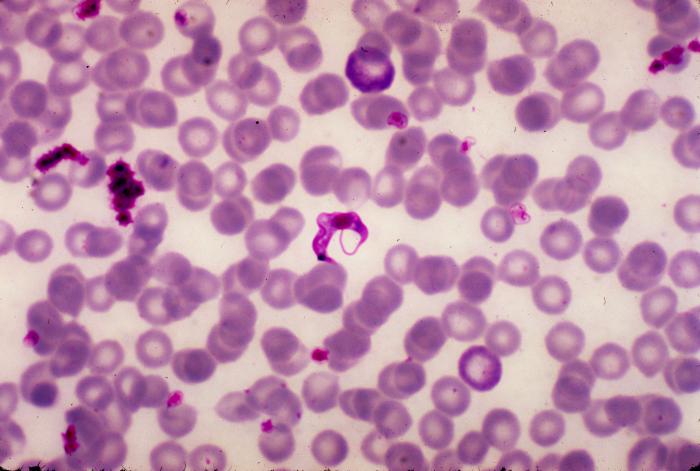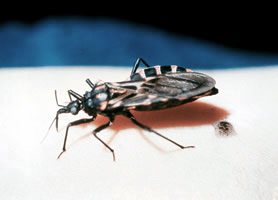April 14, 2017 was World Chagas Day.
Despite 6-7 million patients worldwide, in both poor and wealthy regions, Chagas disease remains one of the most neglected of the neglected tropical diseases globally. Treatments currently exist, however diagnosis remains difficult and current medicines need improving. In addition, the vast majority of patients infected with Trypanosoma cruzi, the parasite causing Chagas disease, remain undiagnosed and simply do not receive or have access to treatment, even in wealthy G20 nations. Healthcare professionals continue to be insufficiently informed about the disease.

The International Society for Neglected Tropical Diseases (ISNTD) held the ISNTD Chagas conference in Washington DC. During the recent conference, Kamran Rafiq, ISNTD Communications Director asked a great panel of experts a number of questions on Chagas disease and their views on the current gaps and priorities in Chagas disease control and patient advocacy.
Among the panel was National School of Tropical Medicine at Baylor College of Medicine, Dean; Sabin Vaccine Institute, President; Texas Children’s Hospital Endowed Chair of Tropical Pediatrics and a expert guest several times on the Outbreak News This Week Radio Show in the Tampa Bay area, Dr. Peter Hotez.
Here are some of the questions and the answers provided by Dr. Hotez:
Kamran Rafiq: To the wider global health & NTD community, Chagas disease has always been synonymous with Latin America and, within that geography, linked to the associative indicators of poverty – lack of access to medicine, clean water or sanitation, ill-planned settlements and urbanization… However, there are now growing estimates ranging from 300,000 to 1 million cases of Chagas disease in the USA – what is driving this rise?
Dr. Peter Hotez: We’re not certain if there really is a rise or whether we just don’t have the active surveillance data in place to know for sure. Recent CDC estimates indicate that there are just under 300,000 3 cases. In Texas where we are working, there is clearly transmission of human Chagas disease from kissing bugs underway. But it’s unclear outside of Texas how much disease is due to active transmission within US borders versus immigration. Here in Texas, factors likely linked to Chagas disease transmission include poverty and climate change.
KR: There is obviously a pressing need to raise awareness both in the affected populations – as an example, Latin American migrant workers living in the USA – and also the wider population. In your opinion what would be the most important blend of messages to send out?
PH: : Because Chagas disease is mostly a neglected disease of poverty, it seldom commands the attention of other global health threats. So it’s a disease of the voiceless poor. We need to get the word out that Chagas disease is one of the most common causes of heart disease among the poor living in the western hemisphere. According to the WHO, approximately 1.1 million people living with Chagas disease now have heart disease (Chagas cardiomyopathy). Sadly we know from the BENEFIT study reported in the New England Journal of Medicine in 2015, approximately 17-18% of those individuals will die over the next 5 years from their disease. We need to make more people aware and enlist the clergy, especially the Catholic Church, the celebrity community, and leaders of government more aware.
I’m particularly concerned that most people living with Chagas disease now live in the four wealthiest nations in the western hemisphere: Argentina, Brazil, Mexico and the USA. This means it’s not a resource problem it’s an awareness and advocacy problem!
KR: Congenital Chagas has the potential to significantly raise the number of Chagas disease cases. How well are physicians equipped & educated to spot and diagnose this?
PH: Studies conducted by Susan Montgomery and her colleagues at CDC reveal that there is almost zero awareness by obstetricians regarding the high rate of maternal and congenital infection. This means that there is practically no awareness right now.
KR: In light of the types of messages and call to action that you’ve highlighted, which types of stakeholder do you think will play an important role in this healthcare messaging or awareness raising phase?
PH: The ignorance surrounding Chagas disease is pervasive. We have mostly failed to get the word out, an issue which I hope we can address at the ISNTD summit.
KR: We have come out of the BENEFIT and STOP clinical trials which highlighted important challenges such as the lack of animal models for the disease, difficulties in clinical trial design, lack of biomarkers for endpoint measurement… In your opinion where does the R&D community have to now focus its efforts?

Image/CDC
PH: In my opinion based on the scary results of the BENEFIT study showing 17-18% of people with Chagasic cardiomyopathy will die from their disease, we urgently need better drugs, diagnostics, and/or therapeutic vaccines, in addition to more basic research.
KR: What kind of partnerships and collaborations between endemic countries and the USA would be useful in tackling Chagas?
PH: So far the donor community committed to global health has mostly ignored Chagas disease. We need to get Chagas disease on the radar screen of the major governments and private philanthropies focused on the world’s poor.
LISTEN to Dr Hotez’s keynote presentation at the ISNTD Chagas conference: “Chagas disease, NTDs, in the time of Blue Marble Health & the Anthropocene Epoch”
See the full transcript of the Q&A HERE
Interviews with Dr Hotez on the Outbreak News This Week Radio Show:
- Old World cutaneous leishmaniasis outbreak in conflict zones: An interview with Dr Peter Hotez
- Dr. Peter Hotez discusses his new book, ‘Blue Marble Health’
- Outbreak News Radio: Chagas disease in North America
- Outbreak News Radio: Leishmaniasis, Polio-like paralysis
- Texas measles prediction: Outbreaks by 2018
Other Chagas disease news and interviews:
- Chagas disease: An interview with Patricia Dorn, PhD
- Chagas study: Confirms it is a major public health challenge for the US
- Chagas disease vector spread linked to cardboard boxes: Study
- Chagas, leishmaniasis and sleeping sickness cured with one drug? Researchers get a little closer


2 thoughts on “Dr. Peter Hotez on World Chagas Day 2017”